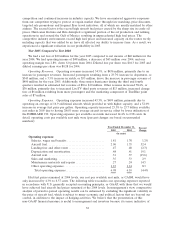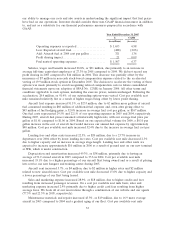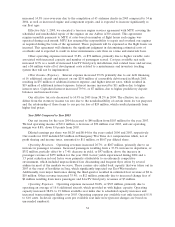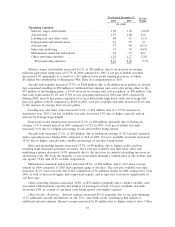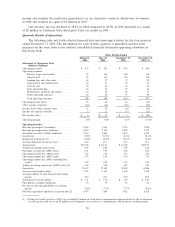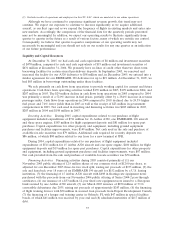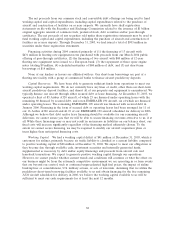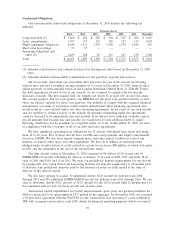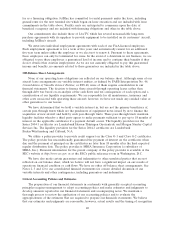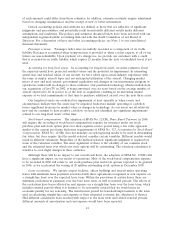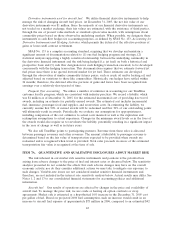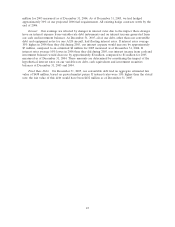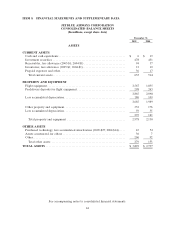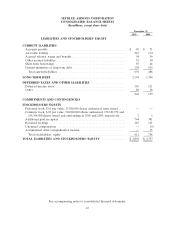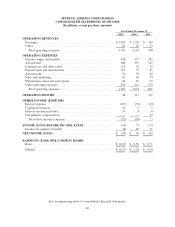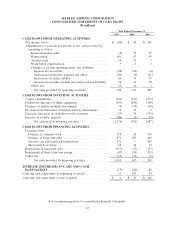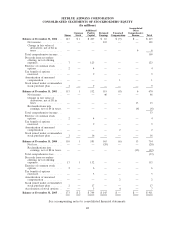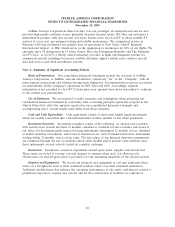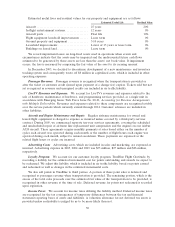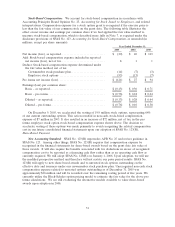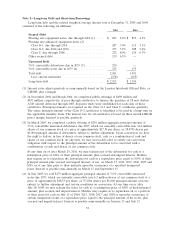JetBlue Airlines 2005 Annual Report Download - page 50
Download and view the complete annual report
Please find page 50 of the 2005 JetBlue Airlines annual report below. You can navigate through the pages in the report by either clicking on the pages listed below, or by using the keyword search tool below to find specific information within the annual report.Derivative instruments used for aircraft fuel. We utilize financial derivative instruments to help
manage the risk of changing aircraft fuel prices. At December 31, 2005, the net fair value of our
derivative instruments was $1 million. Since the majority of our financial derivative instruments are
not traded on a market exchange, their fair values are estimated, with the assistance of third parties,
through the use of present value methods or standard option value models, with assumptions about
commodity prices based on those observed in underlying markets. When possible, we designate these
instruments as cash flow hedges for accounting purposes, as defined by SFAS No. 133, Accounting for
Derivative Instruments and Hedging Activities, which permits the deferral of the effective portions of
gains or losses until contract settlement.
SFAS No. 133 is a complex accounting standard, requiring that we develop and maintain a
significant amount of documentation related to (1) our fuel hedging program and strategy, (2)
statistical analysis supporting a highly correlated relationship between the underlying commodity in
the derivative financial instrument and the risk being hedged (i.e. jet fuel) on both a historical and
prospective basis and (3) cash flow designation for each hedging transaction executed, to be developed
concurrently with the hedging transaction. This documentation requires that we estimate forward jet
fuel prices since there is no quoted forward market for jet fuel. These estimates are developed
through the observation of similar commodity futures prices, such as crude oil and/or heating oil, and
adjusted based on variations to those like commodities. Historically, our hedges have settled within
24 months; therefore, the deferred effective portions of gains and losses have been recognized into
earnings over a relatively short period of time.
Frequent flyer accounting. We utilize a number of estimates in accounting for our TrueBlue
customer loyalty program, which are consistent with industry practices. We record a liability, which
was $1 million as of December 31, 2005, for the estimated incremental cost of providing free travel
awards, including an estimate for partially earned awards. The estimated cost includes incremental
fuel, insurance, passenger food and supplies, and reservation costs. In estimating the liability, we
currently assume that 90%of earned awards will be redeemed and that 30%of our outstanding points
will ultimately result in awards. Periodically, we evaluate our assumptions for appropriateness,
including comparison of the cost estimates to actual costs incurred as well as the expiration and
redemption assumptions to actual experience. Changes in the minimum award levels or in the lives of
the awards would also require us to reevaluate the liability, potentially resulting in a significant impact
in the year of change as well as in future years.
We also sell TrueBlue points to participating partners. Revenue from these sales is allocated
between passenger revenues and other revenues. The amount attributable to passenger revenue is
determined based on the fair value of transportation expected to be provided when awards are
redeemed and is recognized when travel is provided. Total sales proceeds in excess of the estimated
transportation fair value is recognized at the time of sale.
ITEM 7A. QUANTITATIVE AND QUALITATIVE DISCLOSURES ABOUT MARKET RISK
The risk inherent in our market risk sensitive instruments and positions is the potential loss
arising from adverse changes to the price of fuel and interest rates as discussed below. The sensitivity
analyses presented do not consider the effects that such adverse changes may have on the overall
economic activity, nor do they consider additional actions we may take to mitigate our exposure to
such changes. Variable-rate leases are not considered market sensitive financial instruments and,
therefore, are not included in the interest rate sensitivity analysis below. Actual results may differ. See
Notes 1, 2 and 13 to our consolidated financial statements for accounting policies and additional
information.
Aircraft fuel. Our results of operations are affected by changes in the price and availability of
aircraft fuel. To manage the price risk, we use crude or heating oil option contracts or swap
agreements. Market risk is estimated as a hypothetical 10%increase in the December 31, 2005 cost
per gallon of fuel. Based on projected 2006 fuel consumption, such an increase would result in an
increase to aircraft fuel expense of approximately $73 million in 2006, compared to an estimated $42
42


